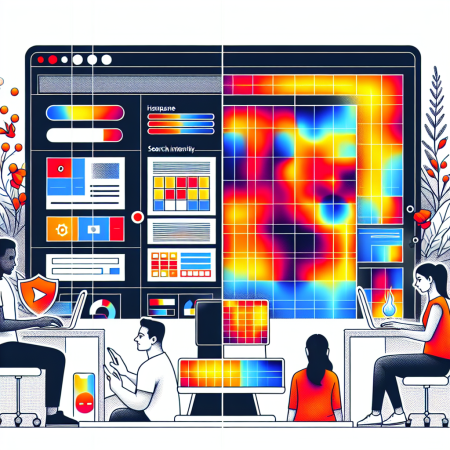How to Use Heatmaps to Improve User Experience
Heatmap Analysis for User Experience
Introduction:
Heatmaps are graphical representations of data that use color-coding to indicate different values. In the context of user experience analysis, heatmaps provide valuable insights into how users interact with a website or application.
Types of Heatmaps:
There are several types of heatmaps used in user experience analysis, including click maps, scroll maps, and move maps. Each type offers unique insights into user behavior and helps identify areas for improvement.
Benefits of Heatmap Analysis:
By utilizing heatmap analysis, businesses can gain a better understanding of user behavior, identify popular or problematic areas of a website, and make data-driven decisions to enhance the overall user experience.
Conclusion:
Heatmap analysis is a powerful tool for improving user experience by providing visual representations of user behavior and interactions.
Utilizing Heatmaps for Improving UX
Introduction:
Utilizing heatmaps is essential for optimizing user experience as it allows businesses to visualize user interactions in a meaningful way. By analyzing heatmap data, organizations can make informed decisions to enhance user experience.
Implementing Heatmap Tools:
There are various heatmap tools available that enable businesses to track and analyze user behavior effectively. These tools provide actionable insights that can be used to improve website usability and conversions.
Interpreting Heatmap Data:
Understanding and interpreting heatmap data is crucial for making the most out of user behavior insights. By identifying patterns and trends in heatmap data, businesses can prioritize improvements for maximum impact.
Enhancing UX Design:
By leveraging heatmap data, organizations can optimize UX design elements such as call-to-action buttons, layout structure, and content placement to create a more intuitive and engaging user experience.
Enhancing User Experience with Heatmaps
Introduction:
Enhancing user experience with heatmaps involves leveraging visual data representations to identify key areas for improvement on a website or application. By focusing on user behavior insights, businesses can enhance overall user satisfaction.
Heatmaps for Conversion Rate Optimization:
Heatmaps are invaluable tools for conversion rate optimization as they reveal user interactions that directly impact conversion rates. By analyzing heatmap data, businesses can make targeted changes to increase conversions.
Improving Navigation with Heatmaps:
Heatmaps can pinpoint navigation issues on a website by highlighting where users click and scroll most frequently. By addressing navigation pain points, businesses can streamline the user journey and reduce bounce rates.
Personalizing User Experience:
Utilizing heatmaps to understand user behavior allows for personalized user experiences tailored to individual preferences. By customizing content and design based on heatmap insights, businesses can create more relevant interactions.
Heatmaps and User Behavior Analysis
Introduction:
Heatmaps play a crucial role in user behavior analysis by providing visual representations of how users engage with digital interfaces. By studying heatmap data, businesses can gain valuable insights into user preferences and interactions.
Identifying User Preferences:
Through heatmap analysis, businesses can identify user preferences for specific content, features, and design elements. Understanding these preferences enables businesses to tailor their offerings for a more personalized user experience.
Behavior Flow Analysis:
Heatmaps can help businesses track user behavior flow on a website or application, highlighting common paths users take and potential points of drop-off. This insight enables businesses to optimize the user journey for improved engagement.
A/B Testing with Heatmaps:
By using heatmaps in conjunction with A/B testing, businesses can compare the effectiveness of different designs or features in real-time. This data-driven approach allows for iterative improvements based on user feedback and interactions.
Optimizing User Experience with Heatmap Tools
Introduction:
Optimizing user experience with heatmap tools involves leveraging data-driven insights to make informed decisions about website design and functionality. By utilizing heatmap tools effectively, businesses can create more user-friendly interfaces.
Heatmap Integration:
Integrating heatmap tools into the design and development process allows for continuous monitoring of user behavior and engagement. This integration facilitates data-driven decision-making and ongoing improvements to the user experience.
Responsive Design Optimization:
Heatmaps can reveal how users interact with a website across different devices and screen sizes, highlighting the need for responsive design optimization. By optimizing for various devices, businesses can enhance accessibility and user satisfaction.
Iterative Improvement:
Utilizing heatmap tools for iterative improvement enables businesses to test and refine design elements based on user feedback. By continuously analyzing heatmap data, organizations can evolve their user experience strategy to meet changing user needs.
FAQ
Q: How do heatmaps help improve user experience?
A: Heatmaps provide visual insights into user behavior, allowing businesses to identify issues, optimize design elements, and personalize user experiences for enhanced satisfaction.
Q: What types of heatmaps are commonly used for user experience analysis?
A: Click maps, scroll maps, move maps, and attention maps are commonly used heatmaps for analyzing user behavior and optimizing user experience.
Q: How can heatmap data be interpreted for UX improvements?
A: By identifying patterns, trends, and hotspots in heatmap data, businesses can prioritize areas for improvement, optimize navigation, and enhance design elements to improve user experience.
Q: Why is A/B testing with heatmaps beneficial for user experience optimization?
A: A/B testing with heatmaps allows businesses to compare design variations, track user interactions, and make data-driven decisions to optimize user experience and conversion rates.
Q: How can businesses integrate heatmap tools for ongoing user experience enhancements?
A: Businesses can integrate heatmap tools into their design and development process for continuous monitoring, responsive design optimization, and iterative improvements based on user behavior insights.

